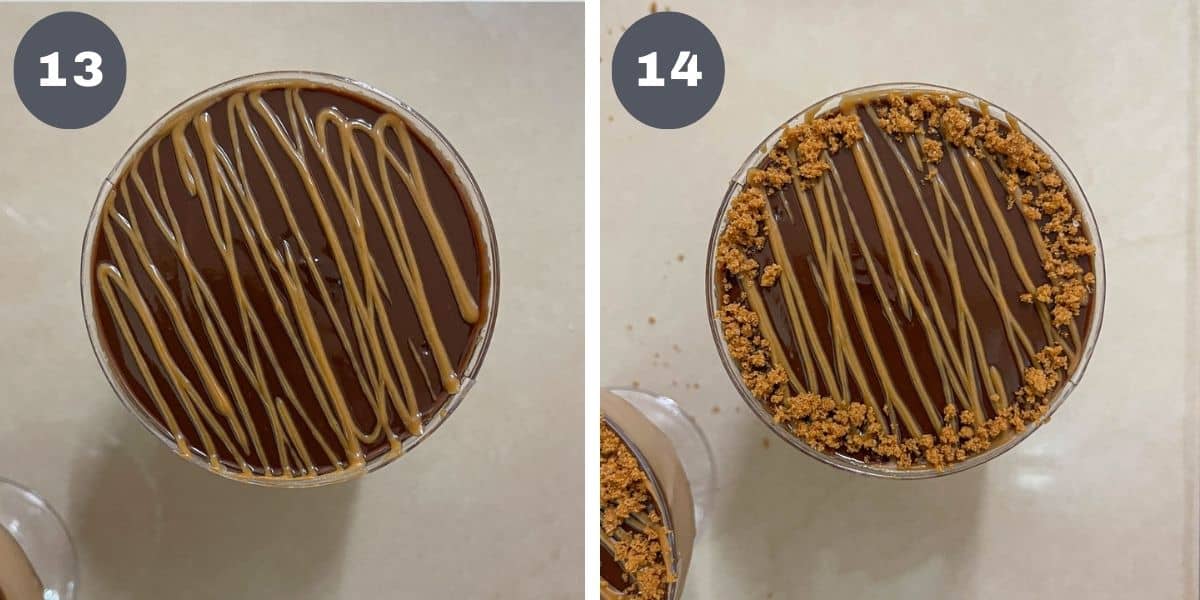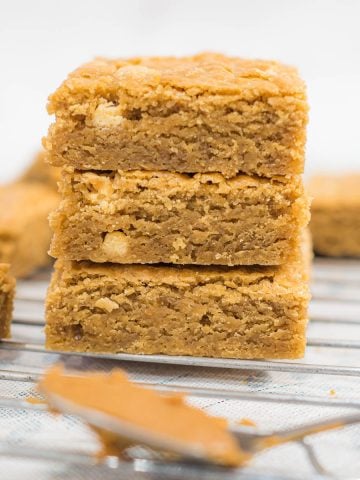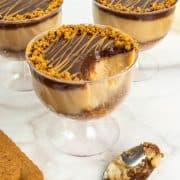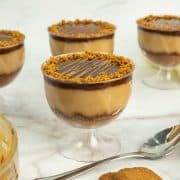This Lotus Biscoff pudding recipe makes decadent cookie butter flavored pudding with delicious layers of Biscoff biscuit crumbs, silky smooth Biscoff flavored pudding and a rich layer of dark chocolate ganache in individual serving cups. With simple ingredients, this pudding is very easy to make too!

All you need to make this delicious pudding are Biscoff spread, Biscoff cookies, milk, sugar, cornstarch, dark chocolate and heavy cream (plus salt and vanilla extract for flavor).
The combination of the crunchy cookie crumbs, the smooth Biscoff vanilla custard and rich chocolate ganache makes a super pleasant, unbelievable flavor combo in this fabulous dessert. Served in cups, these individual serving treats are perfect for Biscoff lovers and sweet tooths.
For more creamy and luscious desserts, try this mascarpone chocolate mousse, kiwi mousse, durian mousse and apple mousse. They make equally delicious dessert cups too.
Jump to:
❤️Why You Will Love This Recipe
- This is a no bake dessert, so no baking is required and you do not need any electric mixer too.
- The pudding can be made in advance and kept chill in the fridge, making it easy to serve them.
- Serving in cups saves the hassle to having to scoop the pudding from a larger tray, and is a great option for parties.
- There is no egg (both egg yolks and egg whites) in this recipe, making it a great dessert option for vegetarians and those on egg-free diet.
What is Lotus Biscoff?
Lotus Biscoff is a brand name of a famous Belgian cookie (also called speculoos cookies) made from a blend of cinnamon and brown sugar. The crunchy and delicious cookies have a lovely spiced and caramelized taste.
In addition to the original cookies, Lotus Biscoff is also well known for its cookie spread (i.e. cookie butter). The cookie butter is a smooth spread made from the crushed cookies and can be used as a topping for toast, waffles, or pancakes.
Lotus Biscoff has gained popularity in many parts of the world and has become a beloved brand known for its unique flavor and versatility in baking and cooking. In addition to being consumed as cookies and as a spread, both of these Lotus cookies (also commonly called Lotus biscuit) and spread are also widely used in baking and in making desserts such as this pudding, perfectly chewy Biscoff blondies, brownies, cakes, truffles, Biscoff butter cookies, Biscoff ice cream and even latte.
📋Ingredients
- Lotus Biscoff cookies (Biscoff biscuits) - these are used to make the cookie crumb layer and as topping. You can purchase them readily from your local grocery stores or supermarkets.
- Whole milk - use full fat milk for a creamy pudding.
- Lotus Biscoff spread (cookie butter) - This is used to flavor the pudding as well as to drizzle on the pudding. The spread is typically sold in 2 versions i.e. the smooth version and the crunchy version. For a smooth pudding, use the smooth version.
- Brown sugar - sweetens and enhances the caramel taste of Biscoff and the pudding.
- Corn starch - helps to thicken the pudding.
- Vanilla extract (vanilla essence) - adds flavoring to the pudding.
- Dark chocolate - this is used for the topping. You can also use dark bittersweet chocolate to make the ganache topping. The taste of dark chocolate complements the sweet taste of the pudding.
- Heavy cream (whipping cream) - this is used to make the chocolate ganache topping.
- Salt - just a small amount to enhance the sweet taste of the pudding.
*Refer to the recipe card below for full list of ingredients and exact quantities. For best results, use a digital kitchen scale where applicable*
🧾Substitution and Variations
- Biscoff cookies can be replaced with other brands of speculoos cookies. Other options include vanilla wafers and chocolate biscuit (chocolate cookies like Oreo). You can also use graham crackers. Similar to using the Lotus biscuits, crush the graham crackers into crumbs and divide the layers of graham cracker crumbs into each pudding cup before adding the Biscoff flavored pudding. You can also use additional graham cracker crumbs to decorate the top of the pudding.
- If you are not a fan of chocolate ganache, you can leave the ganache out completely or reduce it to a drizzle on the pudding. Here are other variations to decorate these Biscoff cups:
- A simple drizzle of melted peanut butter or Nutella for a slightly nutty taste
- A dallop of whipped cream (whip the cream until soft peaks form) decorated with edible flowers like rose petals for a pretty dessert
- A layer of banana slices on top, followed by a simple swirl of piped whipped cream (whip the cream until stiff peaks form to turn it into piping consistency), topped with Biscoff cookie crumbs
This recipe has not been tested with other substitutions or variations. If you do try, please let me know in the comments section below!
👩🍳How to Make
Step 1: Prepare the cookie crumb layer. To make the crumbs, crush the Biscoff cookies into fine crumbs. You can do this in a food processor.

Or place the biscuits in a zip lock bag and crush them with a rolling pin until they achieve wet sand-like texture (image 1).
Divide the cookie crumbs into the pudding cups equally. To level the layers, use the sides of a small rolling pin to gently press the crumbs down. You need to apply too much pressure. Suffice if they are level.
If you are using rounded bottom cups like the ones I have used, instead of levelling the crumbs into an even layer, you can also press the cookie crumbs to follow the shape of the cups (image 2). That way, you will have a slightly higher cookie crumb layer on the sides as compared to the center and this will give your Biscoff pudding a more balanced layers of the cookie crumbs and pudding.
Once you are done with the cookie crumbs, set the cups aside while you prepare the pudding mix.
Step 2: Cook the pudding. To make the pudding, measure the brown sugar into a small bowl.

Add the cornstarch to the sugar (image 3). Mix to combine well.
Note: Mixing helps avoid the corn starch from clumping when added into the hot milk later.
Next, add half cup of milk into the sugar mixture. Mix well and set aside (image 4).

In a separate saucepan, add the remaining milk. Measure in the Biscoff cookie spread, vanilla extract and salt (image 5).
Turn on the heat to medium low and cook until the cookie butter is all melted and the mixture is smooth (make sure there are no cookie butter lumps left unmelted) (image 6).
Turn off the heat and add the brown sugar - corn starch mixture. Whisk quickly to avoid the cornstarch from clumping. Turn on the heat to a low flame and cook the pudding mixture, stirring constantly to avoid it from thickening too much at the bottom and the sides.

Cook the pudding until it thickens. If you notice any lumps in the pudding, turn off the heat and strain it. Do it before the pudding thickens too much. To strain the pudding, use a fine mesh sieve (image 7). And if the pudding is too thick to flow through, gently push it down with a spoon.
Return the pudding to the saucepan (make sure to use a different saucepan if the earlier one has any clumps in it) and cook until it thickens to your desired consistency (image 8).
Remove the pudding from heat and transfer it into a large bowl. Let is cool slightly. Keep stirring the pudding often to avoid a skin from forming on the top. If you are not going to assemble the pudding cups immediately, cover the pudding with a plastic wrap, making sure the wrap touches the top of the pudding. This is to avoid skin from forming on the pudding.
Step 3: Pour the pudding into the cups. Once the pudding has cooled down slightly, you can pour it into the prepared pudding cups.

Pour it gently and equally into the earlier prepared pudding cups with the cookie crust (image 9).
To level the tops, simply tap the cups lightly on your kitchen counter top or shake the cups gently, horizontally (image 10).
Set the pudding cups aside to cool further and then place them in the refrigerator to set.
Step 4: Add the chocolate ganache topping. To make the chocolate ganache, place the cream into a heat proof bowl. Heat it up until it starts to bubble at the sides. You can do this is a double boiler.

Once the cream is heated up, add the chocolate (image 11). Turn off the heat.
Note: If you are using a chocolate bar, chop it into small pieces for easy melting. If you are using chocolate chips, no need to chop them further.
Stir to combine the cream and the chocolate and until it becomes smooth.
Let the ganache cool down to room temperature before using. For best results, the ganache must still be in a thick custard consistency.
Note: If you notice the ganache setting at room temperature, heat it up again slightly and use it before it sets again. The rate at which the ganache sets depends on your room temperature. If you are in a hot climate, it will not set at room temperature, but if you are in a cold climate, it will set quickly.
Spoon the chocolate ganache over the pudding layers (image 12). Turn the pudding cups to spread the ganache all over the top into a thin layer.
Step 5: Add the Biscoff drizzle and cookie crumbs. For the Biscoff drizzle, place the Biscoff spread in a heat proof bowl and place the bowl over a pan of hot water. No need to turn on the heat.
Stir the cookie butter until it turns into a soft consistency.

Transfer it into a piping bag. Snip the tip (make a small tiny hole only) and pipe it onto the top of the pudding in diagonal lines (image 13).
For the final touch, crush the Biscoff biscuit and sprinkle it all around the edges of each pudding cup to create a pretty border for the Biscoff pudding cups (image 14).
Chill the pudding until ready to serve. The pudding is best kept refrigerated and last for a good 3 to 4 days.

💡Expert Tips
- Mixing the cornstarch with sugar before adding into hot milk will avoid it from clumping. If you still notice clumps, strain the pudding.
- If you are not going to assemble the pudding cups immediately after the pudding is cooked, cover the pudding with a plastic wrap, making sure the wrap touches the top of the pudding. This is to avoid a skin from forming on the pudding.
- For easy pouring of the pudding into the cups, use a jug with pouring lip.
💭FAQs
Chill the pudding until ready to serve. The pudding is best kept refrigerated and last for a good 3 to 4 days.
Working with corn starch can be tricky especially if you are adding it as a thickening agent into hot liquid as is the case with this pudding. This is because corn starch tends to get lumpy when added into hot liquid if not stirred quickly.
The best way to handle corn starch is to sift it first before adding into any liquid so that there are no lumps.
Secondly, it also helps to mix it with ingredients like sugar (if the recipe calls for sugar), so that it is dispersed and does not get a chance to lump.
And the final way is to dilute it with a small amount of liquid, so that it is disperses in the liquid and does not lump up when added to the hot liquid.
Yes, you can make this pudding into a single large pie.
Use a large glass baking dish or pie plate to spread the cookies crumbs. Press them down to form a compact layer of cookie crumbs before adding the Biscoff pudding layer on top, followed by the ganache and drizzle.

❤️More Recipes You Will Love
Do you like this recipe? Please leave a 5-star ⭐⭐⭐⭐⭐rating in the recipe card below and consider a review further down this page. I would love to hear from you. Thank you!
📖Recipe

Biscoff Pudding
For best results, use the metrics measurements. US customary measurements have not been tested and are only meant for guide.
Ingredients
Cookie Crust
- 10 Biscoff cookies
Pudding
- 500 ml milk
- 150 g Lotus Biscoff spread
- 75 g brown sugar
- 3 tablespoon corn starch
- 1 teaspoon vanilla extract
- ⅛ teaspoon salt
Topping
- 75 ml heavy cream
- 75 g dark chocolate
- 1 Lotus Biscoff cookie
- 2 tablespoon Lotus Biscoff spread
Instructions
- Crush Biscoff cookies into a fine crumb. You can do this in a food processor. Or place the biscuits in a zip lock bag and crush them with a rolling pin until they achieve wet sand-like texture.
- Divide the cookie crumbs into prepared pudding cups equally.
- To level the layers, use the sides of a small rolling pin to gently press the crumbs down.
- If you are using round bottom cups, press the cookie crumbs to follow the shape of the cups to have a slightly higher cookie crumb layer on the sides as compared to the center.
- Set the crust aside.
- To make the filling, measure brown sugar into a small bowl. Add cornstarch to the sugar. Combine well (see Note 1).
- Next, add half cup of milk into the sugar mixture. Mix well and set aside.
- In a separate saucepan, add the remaining milk. Measure in the Biscoff cookie spread, vanilla extract and salt.
- Turn on the heat to medium low and cook until the cookie butter is all melted and the mixture is smooth (make sure there are no cookie butter lumps left unmelted).
- Turn off the heat and add the brown sugar - corn starch mixture. Whisk quickly to avoid the cornstarch from clumping. Turn on the heat to a low flame and cook the pudding mixture, stirring constantly to avoid it from thickening too much at the bottom and the sides.
- Cook the pudding until it thickens. If you notice any lumps in the pudding, turn off the heat and strain it. Do it before the pudding thickens too much. To strain the pudding, use a fine mesh sieve. And if the pudding is too thick to flow through, gently push it down with a spoon. Return the pudding to the saucepan (make sure to use a different saucepan if the earlier one has any clumps in it) and cook until it thickens to your desired consistency.
- Remove the pudding from heat and transfer it into a large bowl. Let is cool slightly. Keep stirring the pudding often to avoid a skin from forming on the top (see Note 2).
- Once the pudding has cooled down slightly, pour it into the prepared crust equally (see Note 3).
- To level the tops, simply tap the cups lightly on your kitchen counter top or shake the cups gently, horizontally.
- Set the pudding cups aside to cool further and then place them in the refrigerator to set.
- To make chocolate ganache, place heavy cream into a heat proof bowl. Double boil until the sides start to bubble. Turn off the heat and add the chocolate (see Note 4).
- Stir to combine the cream and the chocolate and until it becomes smooth.
- Let the ganache cool down to room temperature before using (see Note 5). For best results, the ganache must still be in a thick custard consistency.
- Spoon the chocolate ganache over the pudding layers. Shake the pudding cups lightly sidesways to spread the ganache all over the top of the pudding into a thin layer.
- For the Biscoff drizzle, place the Biscoff spread in a heat proof bowl and place the bowl in a pan of hot water. No need to turn on the heat.
- Stir the cookie butter until it turns into a soft consistency.
- Transfer it into a piping bag. Snip the tip (make a small tiny hole only) and pipe it onto the top of the pudding in diagonal lines.
- For the final touch, crush the Biscoff biscuit and sprinkle it all around the edges of each pudding cup to create a pretty border for the Biscoff pudding cups.
- Chill the pudding until ready to serve. The pudding is best kept refrigerated and last for a good 3 to 4 days.
Notes
- This is to avoid the corn starch from clumping when added into the hot milk later.
- If you are not going to assemble the pudding cups immediately after the pudding is cooked, cover the pudding with a plastic wrap, making sure the wrap touches the top of the pudding. This is to avoid a skin from forming on the pudding.
- For easy pouring of the pudding into the cups, use a jug with pouring lip.
- If you are using a chocolate bar, chop it into small pieces for easy melting. If you are using chocolate chips, no need to chop them further.
- If you notice the ganache setting at room temperature, heat it up again slightly and use it before it sets again. The rate at which the ganache sets depends on your room temperature. If you are in a hot climate, it will not set at room temperature, but if you are in a cold climate, it will set quickly.











Leave a Reply